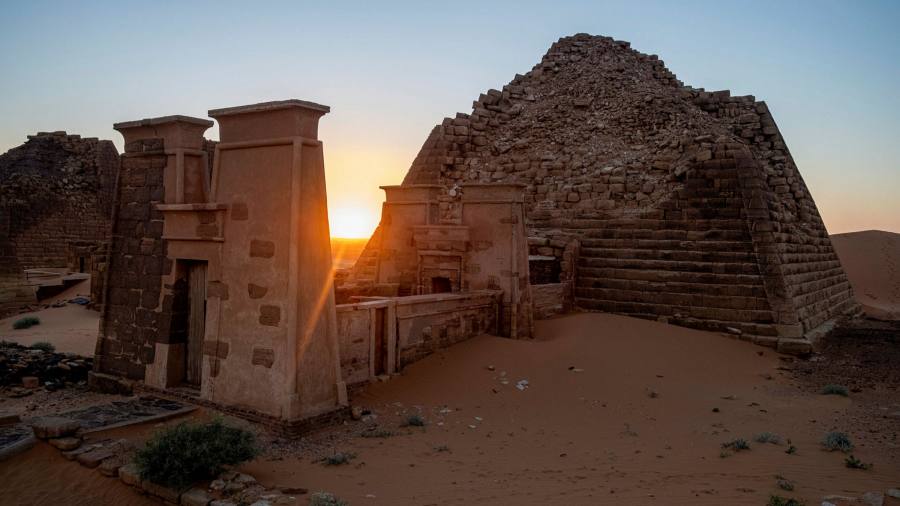[ad_1]
When the camel’s feet sank into the sands of the Nubian Desert, it was time to get out of the saddle — and look up in awe at Sudan’s greatest archaeological treasure, rising from the dunes.
Here, the pyramids of the royal city of Meroë, a site of the Kushite kingdom dating from the eighth century BC, are smaller than their Egyptian counterparts in Giza, at roughly 30m high.
But there are many more, about 100 some 200km from Khartoum, though their tops were blown up in 1834 by Italian treasure hunter Giuseppe Ferlini as he plundered their contents.
The site is largely unvisited by outsiders, apart from the odd group of diplomats, aid workers, and young residents of Khartoum. Stepping alone into one of the world’s greatest archaeological sites may be marvellous for one lucky visitor, but it is also testament to the sluggish state of Sudanese tourism.
“This is the biggest concentration of pyramids in the world. You don’t see such a number in one place anywhere else,†says Mahmoud Suliman Bashir, the archaeologist who manages the Island of Meroë World Heritage Site.
“It is unique in that you have a site just for yourself,†he adds, comparing the experience with that of other sites with pyramids in Egypt and Mexico, usually teeming with global tourists.Â
With his face framed by a white turban, Abdelmageed Ali, Meroë’s longstanding guardian, runs to open the doors to the sole visitor of the funerary chambers, to reveal walls covered in hieroglyphic carvings. “We need more tourists,†he says. In a country rich in under-visited archaeological sites, his wish may soon come true.

The revolution that ended three decades of dictatorship by Omar al-Bashir in 2019, a peace deal with rebel groups and Sudan’s removal from the US sponsor of terrorism list in 2020 make the country more enticing for foreign visitors.
They may finally be lured not only by diving in the Red Sea, but also by some of Africa’s most spectacular treasures, such as the Temple of Amun at Jebel Barkal, the lion-headed god Apedemak in Naqa and the elephant carving at the temple at Musawwarat.
“The main reason for tourism here is the cultural and archaeological sites. We are so optimistic for the future of tourism and the future of archaeology,†says Hatim Elnour Mohamed, who heads Sudan’s General Authority of Antiquities and Museums. The hospitable Sudanese people — still unaccustomed to mass tourism — are another reason, he adds. He also complains, rightly, about a lack of tourism infrastructure. However, the expansion of a permanent luxury tented camp on a ridge overlooking the pyramids, established by the Italian Tourism Company (ITC), one of the largest private operators in the country, hints at the possibilities.


“Sudan’s potential is incredible,†says Carla Piazza, ITC’s director, who has been operating in Sudan for two decades. “Sudan is not yet ready for big numbers, yet it is ready for gradual growth and the country needs to understand that,†she says. Pavel Kroupkine, Unesco’s representative to Sudan, which has three heritage sites, says the potential is “hugeâ€.
But tourism visas to enter Sudan and official travel permits to roam outside Khartoum are still cumbersome to obtain, and western credit cards are rarely accepted. Still, Sudan desperately needs hard currency, “so the country and its people merit all possible effort to fix this,†adds Ms Piazza.
According to the World Bank’s latest available data, international tourism receipts amounted to about $1bn, or 3 per cent of Sudan’s gross domestic product in 2018, which Ms Piazza described as a “record†year. Officials expect that proportion to rise to 5 per cent in the coming years.
It may be a hard slog. The coronavirus pandemic has disrupted global travel, forcing Meroë, a Unesco World Heritage Centre, to close for four months last year — just as cultural tourism was starting to take off. The first wave of tourists came in 2017 after a visit by Qatar’s Sheikha Moza bint Nasser. In 2014, Qatar, then an ally of Bashir, granted Sudan $135m to rehabilitate ancient relics, part of its package of financial aid to the African country. The money was partly used to set up a visitor’s centre and walking tracks, so “for the first time, we started to have internal tourism, for the first time Sudanese started to visit the pyramids, because they saw that [visit on] social media, and they came to see the place,†says Mahmoud Suliman Bashir, the archaeologist.Â
The second wave came in 2019 after the street protests that led to the downfall of Bashir. The protests were mainly led by women, known as Kandaka — the term for queens of Meroë who led armies into battle millennia ago.Â
“We started to have buses every weekend full of young locals. We also had more international tourists who wanted to know about our civilisations as it was safer and easier to come, as the previous regime was restricting issuing visas to some citizens of Europe and the US,†Mahmoud Suliman Bashir recalls.
The sunset flashes across the pyramids as nomads play zumbara flutes, and camel caravans cross the site. Ali Mohammed Ebd, who manages the tented camp, reminds foreign visitors that sundowners cannot yet be served in Sudan, even after the lifting of some Islamists laws last year. Alcohol is still banned in most places.
“Still, post-Bashir, post-US sanctions, post-civil war Sudan is quiet, so we can have more tourists who can experience this almost as it was thousands of years ago,†he says.
[ad_2]
Source link







